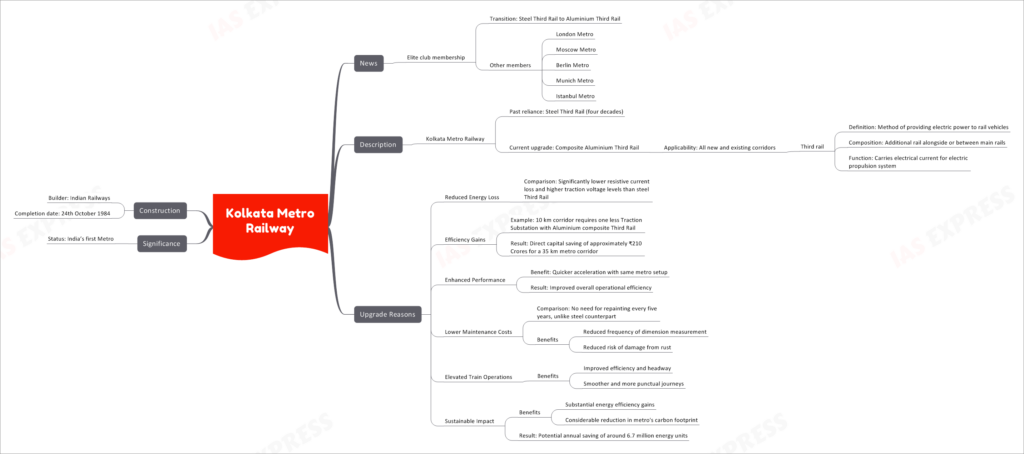Kolkata Metro Railway

In a significant stride towards technological advancement, the Kolkata Metro Railway has recently joined the elite club of metro networks making the transition from Steel Third Rail to the more innovative and efficient Aluminium Third Rail. This development aligns Kolkata Metro Railway with esteemed counterparts like the London Metro, Moscow Metro, Berlin Metro, Munich Metro, and Istanbul Metro.
Description: Embracing Innovation
The Kolkata Metro Railway, renowned as India’s first metro, has historically relied on the Steel Third Rail for over four decades. However, the recent upgrade to the Composite Aluminium Third Rail marks a pivotal transition in powering the metro network.
Composite Aluminium Third Rail: Empowering Progress
The Composite Aluminium Third Rail is a revolutionary method of providing electric power to rail vehicles. It consists of an additional rail alongside or between the main rails, functioning as the conduit for the electric propulsion system.
Upgrade Reasons: A Leap Towards Efficiency
The decision to transition to the Aluminium Third Rail stems from a multitude of compelling reasons, each contributing to the overall enhancement of the metro system.
Reduced Energy Loss: A New Paradigm
- Comparison: The Aluminium Third Rail boasts significantly lower resistive current loss and higher traction voltage levels in comparison to the traditional Steel Third Rail.
Efficiency Gains: Capital and Resource Savings
- Example: A 10 km corridor powered by the Aluminium composite Third Rail requires one less Traction Substation.
- Result: This directly translates to a capital saving of approximately ₹210 Crores for a 35 km metro corridor.
Enhanced Performance: Acceleration Redefined
- Benefit: The Aluminium Third Rail enables quicker acceleration with the same metro setup.
- Result: This improvement leads to an enhanced overall operational efficiency of the metro system.
Lower Maintenance Costs: Practical Benefits
- Comparison: Unlike its steel counterpart, the Aluminium Third Rail doesn’t require repainting every five years.
- Benefits: This results in reduced frequency of dimension measurement and lowers the risk of damage from rust.
Elevated Train Operations: Elevating Efficiency
- Benefits: The transition contributes to improved operational efficiency and smoother, punctual journeys for passengers.
Sustainable Impact: Environmentally Friendly
- Benefits: The shift to the Aluminium Third Rail results in substantial energy efficiency gains and a considerable reduction in the metro’s carbon footprint.
- Result: The potential annual saving amounts to around 6.7 million energy units.
Significance: A Pioneer’s Legacy
The Kolkata Metro Railway holds the distinguished title of being India’s first metro, solidifying its significance in the country’s transportation history.
Construction: A Remarkable Endeavor
The Kolkata Metro Railway was constructed under the able guidance of Indian Railways and achieved its completion milestone on October 24th, 1984. This monumental project laid the foundation for urban transportation infrastructure in India, setting a benchmark for future endeavors.
If you like this post, please share your feedback in the comments section below so that we will upload more posts like this.

